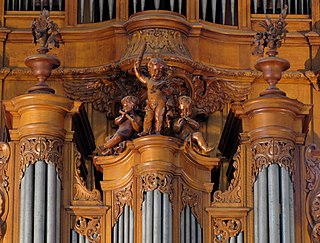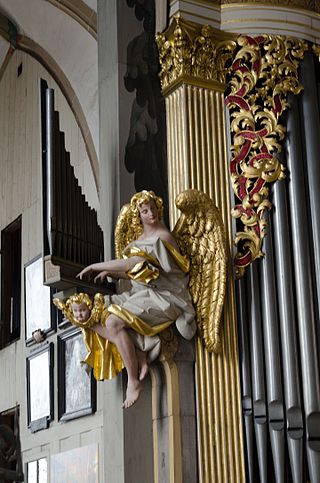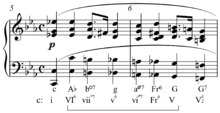
In classical music, a fugue is a contrapuntal, polyphonic compositional technique in two or more voices, built on a subject that is introduced at the beginning in imitation, which recurs frequently throughout the course of the composition. It is not to be confused with a fuguing tune, which is a style of song popularized by and mostly limited to early American music and West Gallery music. A fugue usually has three main sections: an exposition, a development and a final entry that contains the return of the subject in the fugue's tonic key. Fugues can also have episodes—parts of the fugue where new material is heard, based on the subject—a stretto, when the fugue's subject "overlaps" itself in different voices, or a recapitulation. A popular compositional technique in the Baroque era, the fugue was fundamental in showing mastery of harmony and tonality as it presented counterpoint.

In music, the BACH motif is the motif, a succession of notes important or characteristic to a piece, B flat, A, C, B natural. In German musical nomenclature, in which the note B natural is named H and the B flat named B, it forms Johann Sebastian Bach's family name. One of the most frequently occurring examples of a musical cryptogram, the motif has been used by countless composers, especially after the Bach Revival in the first half of the 19th century.
In Western musical theory, a cadence is the end of a phrase in which the melody or harmony creates a sense of full or partial resolution, especially in music of the 16th century onwards. A harmonic cadence is a progression of two or more chords that concludes a phrase, section, or piece of music. A rhythmic cadence is a characteristic rhythmic pattern that indicates the end of a phrase. A cadence can be labeled "weak" or "strong" depending on the impression of finality it gives. While cadences are usually classified by specific chord or melodic progressions, the use of such progressions does not necessarily constitute a cadence—there must be a sense of closure, as at the end of a phrase. Harmonic rhythm plays an important part in determining where a cadence occurs.

A semitone, also called a half step or a half tone, is the smallest musical interval commonly used in Western tonal music, and it is considered the most dissonant when sounded harmonically. It is defined as the interval between two adjacent notes in a 12-tone scale. For example, C is adjacent to C♯; the interval between them is a semitone.
Chromaticism is a compositional technique interspersing the primary diatonic pitches and chords with other pitches of the chromatic scale. In simple terms, within each octave, diatonic music uses only seven different notes, rather than the twelve available on a standard piano keyboard. Music is chromatic when it uses more than just these seven notes.
The Phrygian mode can refer to three different musical modes: the ancient Greek tonos or harmonia, sometimes called Phrygian, formed on a particular set of octave species or scales; the medieval Phrygian mode, and the modern conception of the Phrygian mode as a diatonic scale, based on the latter.
The modern Lydian mode is a seven-tone musical scale formed from a rising pattern of pitches comprising three whole tones, a semitone, two more whole tones, and a final semitone.
D minor is a minor scale based on D, consisting of the pitches D, E, F, G, A, B♭, and C. Its key signature has one flat. Its relative major is F major and its parallel major is D major.
E minor is a minor scale based on E, consisting of the pitches E, F♯, G, A, B, C, and D. Its key signature has one sharp. Its relative major is G major and its parallel major is E major.
B minor is a minor scale based on B, consisting of the pitches B, C♯, D, E, F♯, G, and A. Its key signature has two sharps. Its relative major is D major and its parallel major is B major.

The Eight Short Preludes and Fugues, BWV 553–560, are a collection of works for keyboard and pedal formerly attributed to Johann Sebastian Bach. They are now believed to have been composed by one of Bach's pupils, possibly Johann Tobias Krebs or his son Johann Ludwig Krebs, or by the Bohemian composer Johann Caspar Ferdinand Fischer.

Toccata, Adagio, and Fugue in C major is an organ composition by Johann Sebastian Bach. As is the case with most other organ works by Bach, the autograph score does not survive. The earliest manuscript copies were probably made in 1719–1727. The title of the piece in these copies is given, as expected of organ literature of the time, simply as Toccata in C major. The piece is an early work, probably composed in the mid-to-late Weimar years, i.e. 1710–1717. It shares some similarities with other toccatas composed around the same time, such as BWV 538, BWV 540, and others: all show the influence of concerto style and form.

Prelude and Fugue in A minor, BWV 543 is a piece of organ music written by Johann Sebastian Bach sometime around his years as court organist to the Duke of Saxe-Weimar (1708–1713).

The Well-Tempered Clavier, BWV 846–893, consists of two sets of preludes and fugues in all 24 major and minor keys for keyboard by Johann Sebastian Bach. In the composer's time, clavier referred to a variety of stringed keyboard instruments, most typically the harpsichord or clavichord, but excluding the organ, which is not a stringed keyboard.

The Clavier-Übung III, sometimes referred to as the German Organ Mass, is a collection of compositions for organ by Johann Sebastian Bach, started in 1735–36 and published in 1739. It is considered Bach's most significant and extensive work for organ, containing some of his most musically complex and technically demanding compositions for that instrument.
The Prelude and Fugue in G minor, BWV 861, is No. 16 in Johann Sebastian Bach's Well-Tempered Clavier Book I, keyboard music consisting of 24 preludes and fugues in every major and minor key.

Prelude and Fugue in E minor, BWV 548 is a piece of organ music written by Johann Sebastian Bach sometime between 1727 and 1736, during his time in Leipzig. The work is sometimes called "The Wedge" due to the chromatic outward motion of the fugue theme. Unlike most other organ preludes and fugues of Bach, the autograph fair copy of the score survives, though the handwriting changes twenty two measures into the fugue to the hand of Johann Peter Kellner, a likely pupil and acquaintance of Bach who played an important role in the copying of his manuscripts. Because of the work's immense scope, it has been referred to as "a two-movement symphony" for the organ.
Prelude and Fugue in C major, BWV 870, is a keyboard composition written by Johann Sebastian Bach. It is the first prelude and fugue in the second book of The Well-Tempered Clavier, a series of 48 preludes and fugues in every major and minor key.

The organ sonatas, BWV 525–530 by Johann Sebastian Bach are a collection of six sonatas in trio sonata form. Each of the sonatas has three movements, with three independent parts in the two manuals and obbligato pedal. The collection was put together in Leipzig in the late 1720s and contained reworkings of prior compositions by Bach from earlier cantatas, organ works and chamber music as well as some newly composed movements. The sixth sonata, BWV 530, is the only one for which all three movements were specially composed for the collection. When played on an organ, the second manual part is often played an octave lower on the keyboard with appropriate registration. Commentators have suggested that the collection might partly have been intended for private study to perfect organ technique, some pointing out that its compass allows it to be played on a pedal clavichord. The collection of sonatas is generally regarded as one of Bach's masterpieces for organ. The sonatas are also considered to be amongst his most difficult compositions for the instrument.
The Prelude and Fugue in B-flat major, BWV 866, is a keyboard composition by Johann Sebastian Bach. It is the 21st prelude and fugue in the first book of The Well-Tempered Clavier, a series of 48 preludes and fugues by the composer. It was composed no later than 1722.

 Play (help·info)
Play (help·info)

 Play (help·info).
Play (help·info).










